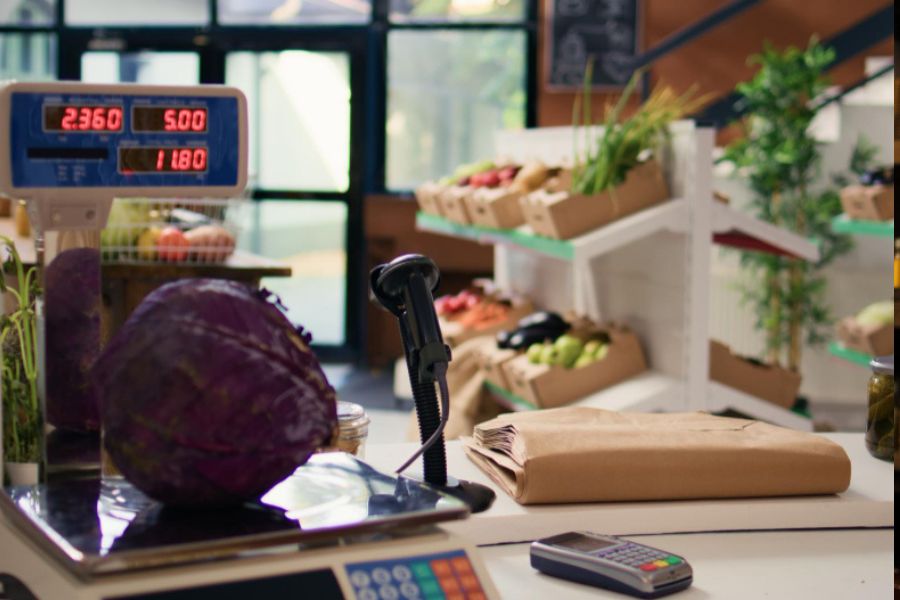Grocery store POS and inventory management software used to be two separate tools. As businesses evolve, they now seek comprehensive solutions that integrate both functions. These combined systems simplify inventory control and enhance customer service. In this article, we will explore how using an integrated grocery store POS & inventory management software can maximize efficiency and improve your grocery store’s overall performance.
Highlights
- Integrated grocery store POS and inventory management software combines sales processing, inventory tracking, and customer management into a single, streamlined system.
- The integrated software’s main benefit is enhanced operational efficiency, resulting in accurate inventory levels, faster checkouts, and improved customer satisfaction.
Integrated POS and Inventory Management Software: What It Means
Components of Modern POS Systems
A modern Point of Sale (POS) system is a comprehensive solution that streamlines various retail operations. In the context of grocery store POS & inventory management software, a POS system encompasses both hardware and software components designed to manage sales, inventory, and customer interactions efficiently.
The hardware components typically include:
- Registers: For processing transactions and printing receipts.
- Barcode Scanners: For quickly and accurately scanning product information.
- Receipt Printers: For generating transaction receipts.
- Card Readers: For processing credit and debit card payments.
- Cash Drawers: For securely storing cash.
The software components of a modern POS system are equally crucial and include features such as:
- Sales Processing: Handling transactions, applying discounts, and calculating totals.
- Inventory Management: Tracking stock levels, managing reorder points, and monitoring product performance.
- Customer Relationship Management (CRM): Storing customer information, managing loyalty programs, and tracking purchase history.
- Reporting and Analytics: Generating reports on sales, inventory, and customer behavior to aid decision-making.
- Integration Capabilities: Connecting with other systems like accounting software, e-commerce platforms, and supplier databases.
Inventory Management Features within POS Systems
Inventory management features within POS systems are critical for grocery stores to maintain optimal stock levels and ensure product availability. Key features include:
- Real-time Stock Tracking: Provides up-to-date information on stock levels for all products, reducing the risk of overstocking or stockouts.
- Automated Reordering: Automatically generates purchase orders when stock levels fall below a predefined threshold, ensuring timely replenishment.
- Product Categorization: Organizes products into categories for easier tracking and management.
- Expiration Date Tracking: Monitors the shelf life of perishable goods, reducing waste by alerting staff to items nearing their expiration dates.
- Supplier Management: Stores supplier details and order histories, simplifying the reordering process and improving supplier relationships.
- Inventory Audits: Facilitates regular stock checks to ensure accuracy and identify discrepancies.
Benefits of Integrated POS and Inventory Management Software for Grocery Stores
Integrated POS and inventory management software offers numerous advantages for grocery stores, improving operations, customer satisfaction, and profitability. Below are some key benefits that highlight the importance of using such systems.
- Multi-location Inventory Management
Managing inventory across multiple store locations can be challenging for grocery retailers. Integrated POS and inventory management software, like ConnectPOS, simplifies this process by providing a centralized system to oversee stock levels in all stores. This system maintains consistent inventory availability, lowers the risk of stockouts, and enables efficient redistribution of stock between locations.
With real-time data, managers can make informed decisions on restocking and inventory transfers, optimizing overall inventory levels.
- Expiration Date Tracking for Perishable Goods
Grocery stores handle a high volume of perishable goods, making expiration date tracking crucial.
Integrated software can automatically track and alert staff about upcoming expiration dates, helping to minimize waste and ensure products are sold while still fresh. This feature reduces losses and ensures customers receive high-quality products.
- Supplier Management and Purchase Order Automation
Managing relationships with multiple suppliers and automating purchase orders are vital for maintaining a smooth supply chain.
Integrated systems streamline supplier management by tracking orders, deliveries, and payment schedules. Automated purchase orders, based on inventory levels and sales forecasts, help maintain optimal stock levels, reducing the need for manual intervention and minimizing the risk of human error.
- Streamlined Checkout Processes and Inventory Tracking
An integrated POS system enhances checkout efficiency by automatically updating inventory levels with each transaction.
This real-time synchronization ensures accurate stock tracking, reduces discrepancies, and speeds up the checkout process. Streamlined checkouts improve customer satisfaction by minimizing wait times and providing a seamless shopping experience.
- Real-time Inventory Visibility and Management
Real-time visibility into inventory levels is essential for effective management. ConnectPOS provides grocery retailers with up-to-date information on stock levels, enabling quick responses to low-stock situations. This real-time insight helps prevent overstocking or stockouts, ensuring that shelves are always stocked with the right products.
The ability to monitor inventory in real-time across all locations enhances operational efficiency and decision-making.
- Enhanced Customer Experience with Accurate Stock Levels
Maintaining accurate stock levels is important for providing a positive customer experience. With ConnectPOS, grocery stores can keep products consistently available, meeting customer demand.
Accurate stock information helps in managing customer expectations and builds trust in the store’s reliability. When customers can reliably find what they need, they are more likely to return, boosting customer loyalty.
- Detailed Sales and Inventory Reporting for Better Decision-making
Detailed sales and inventory reports are invaluable for making informed business decisions.
Integrated software provides comprehensive reports that analyze sales trends, inventory turnover, and product performance. These insights help managers identify best-selling items, slow movers, and seasonal trends, enabling more strategic planning and inventory management. In-depth reporting supports better decision-making and enhances overall store performance.
- Demand Forecasting Using Historical Data and Trends
Accurate demand forecasting helps optimize inventory levels and meet customer demand. Integrated POS and inventory management software analyze historical sales data and market trends to predict future demand accurately. This forecasting capability aids in planning stock levels, scheduling promotions, and managing seasonal fluctuations.
By aligning inventory with anticipated demand, grocery stores can minimize waste, avoid stockouts, and improve overall efficiency.
ConnectPOS is a robust solution for grocery stores seeking to enhance their operations. With real-time inventory tracking, multi-location management, and integrated customer loyalty programs, ConnectPOS streamlines processes and boosts efficiency. Its advanced reporting tools provide valuable insights, helping you make informed decisions and maintain optimal stock levels. By adopting ConnectPOS, grocery retailers can significantly improve their customer experience and overall performance.
Tips for Maximizing Efficiency with Grocery Store POS and Inventory Management Software
Maximizing efficiency with grocery store POS and inventory management software involves strategic use and regular maintenance. We’ve combined some practical tips to help you get the most out of your system.
- Regularly Updating and Maintaining the System
Keep your POS and inventory management software current to benefit from the latest features, improvements, and security enhancements. Regular updates prevent system malfunctions, reduce downtime, and ensure smooth operation.
- Using Data Analytics to Optimize Inventory Levels
Advanced data analytics provide insights into customer purchasing patterns, helping to forecast demand accurately and adjust inventory levels. This proactive approach avoids overstocking and stockouts, boosting profitability and reducing waste.
- Automating Routine Tasks like Reordering and Restocking
Automation tools manage routine tasks such as reordering and restocking. Automation minimizes human error, ensures timely inventory replenishment, and maintains optimal stock levels with minimal manual effort.
- Monitoring and Optimizing Checkout Processes for Speed and Accuracy
Regularly evaluate and refine checkout processes to enhance speed and accuracy. Identify and address bottlenecks to reduce wait times, improve customer satisfaction, and streamline the shopping experience.
- Implementing Customer Loyalty Programs through the POS System
Integrate loyalty programs into your POS system to reward repeat customers and gather valuable data on preferences. Use this data for targeted marketing and tailored promotions to better meet customer needs.
FAQs: Maximizing Efficiency with Grocery Store POS and Inventory Management Software
- How can grocery store POS and inventory management software improve operational efficiency?
By integrating POS and inventory management, grocery stores can streamline processes such as stock tracking, reordering, and sales reporting. This integration reduces manual errors, saves time, and ensures optimal inventory levels.
- What features should I look for in a POS and inventory management system?
Key features include real-time inventory visibility, multi-location management, expiration date tracking, automated reordering, and detailed reporting. These features help in managing inventory efficiently and enhancing overall store performance.
- How does real-time inventory management benefit grocery stores?
Real-time inventory management allows stores to track stock levels instantly, reducing the risk of stockouts and overstocking. It enables better decision-making and ensures that products are always available to meet customer demand.
- Can POS systems help with customer loyalty?
Yes, many POS systems integrate customer loyalty programs, allowing stores to track purchases, offer rewards, and personalize marketing efforts. This fosters customer retention and boosts sales by encouraging repeat business.
Conclusion
Maximizing efficiency in grocery stores is achievable with integrated grocery store POS and inventory management software. This powerful combination simplifies operations, enhances customer satisfaction, and drives profitability. From real-time inventory tracking to streamlined checkout processes, the benefits are clear. Implementing such a system helps maintain optimal stock levels, improve decision-making, and boost overall performance. By adopting integrated grocery store POS and inventory management software, grocery retailers can ensure a seamless and efficient shopping experience for their customers.
For more information on how ConnectPOS’s solutions can help optimize your grocery store operations, please contact us today for a consultation.



